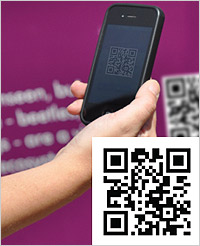Scanbuy Touts Success Of 'First Mobilized Olympics'
- by Mark Walsh @markfwal, September 27, 2012

Along with world-class athletes and aging British pop stars, the Summer Olympics in London provided a high-profile showcase for QR codes. Scanbuy, maker of the ScanLife barcode reader, was the official supplier of code services to the Olympics organizing committee.
In that capacity, the company developed more than 50 unique codes that were displayed in the London Underground, newspapers, throughout Olympic venues and on printed spectator guides. The codes provided information on things like scheduling and events, as well as access to Olympics-related apps.
As for Scanbuy’s own results in London:
From July 20 -- a week before the Games official opening -- to Aug. 12, the company says its technology generated a total of 170,000 total QR code scans, with each user averaging 1.6 scans. The scans helped increase Olympic app downloads to 15 million. Among other highlights:
*Scanning activity peaked early in the Games, on July 28, the day after the Opening Ceremony.
*Those 55 and over proved the most active scanners, accounting for 29% of activity, followed by those 25-24 (24%), and people 35-44 (12).
*Men accounted for the majority of scans, at 61%, to 39% for women.
*iOS drove most mobile scans, with 61%, compared to 23% for Android devices, and 6% for BlackBerry, and 10% for other mobile systems.
Scanbuy CEO Mike Wehrs pointed out that scanning figure might have been significantly higher had BT provided free Wi-Fi at the Olympic Park, as was Scanbuy’s original understanding. BT had exclusive control over W-Fi at the Olympic Park.
"For any of the scans to go through, you were either paying data roaming rates or paying for daily access to the wireless LAN (local area network) if you happened to be in a coverage area, which certainly was not cheap,” he said. Even so, Wehrs says he was pleased with the company’s performance at what he calls the “first mobilized Olympics.”
He suggested that scanning activity peaked in the first couple of days of the Olympics because those who arrived earlier at the Games were using the codes to download various Olympic apps.
While it might seem surprising those 55 and over made up the largest contingent of scanners, Wehrs said that’s likely a factor of the Olympics crowd skewing older and more affluent because of the cost involved in attending the quadrennial event.
Now that it has one Olympics under its belt, Scanbuy is eyeing the opportunity to power QR codes at the upcoming Winter Games in Sochi, Russia as well as the World Cup in Rio de Janeiro in 2014. But Wehrs is insistent that organizers of such global sports events have to make free Wi-Fi a priority.


